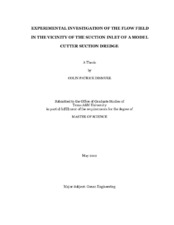| dc.description.abstract | The purpose of this thesis is to describe the three-dimensional velocity flow field measurements in the vicinity of the inlet mouth of a cutterhead suction dredge. Using acoustic Doppler velocimeters (ADVs), an accurate visualization of the velocity flow field was used to determine the region of influence around the cutterhead. Similitude is used in the experimental study to determine the correlation between the velocity flow field and other dredge parameters such as suction intake diameter without the cutterhead and with a rotating cutterhead. This is useful to the dredging community for two reasons: first, knowing the region of influence around the cutterhead helps the dredger achieve higher production by using a more efficient cutting depth and second, achieving similitude with the velocity flow field allows for more accurate model testing in the future.
In order to help understand the more complex flow field around the cutterhead created by the cutting process, scenarios involving three different suction flow rates, three cutterhead rotation speeds, and two swing speeds, were investigated.
Prior studies of the flow field around the cutterhead provided a means to predict the velocity at the cutterhead intake. The flow field studies herein provide an extension into three dimensions as well as a verification of the previous results.
The highest velocities were found to occur nearest the cutterhead, specifically in the lower hemisphere of the cutterhead where the suction intake is located. The magnitude of these values greatly decreased with increasing distance from the cutterhead. In addition, the flow rate is shown to directly correlate to the velocity around the cutterhead.
It was found that the region of influence was nearly symmetrical around the cutterhead, but the shape could more accurately be described as an ellipsoid. The volumes of the regions of influence ranged from 10 ft^3 (0.283 m^3) to 80 ft^3 (2.27 m^3) for the model dredge and from 2,250 ft^3 (63.70 m^3) to 17,000 ft^3 (481.40 m^3). | en |


